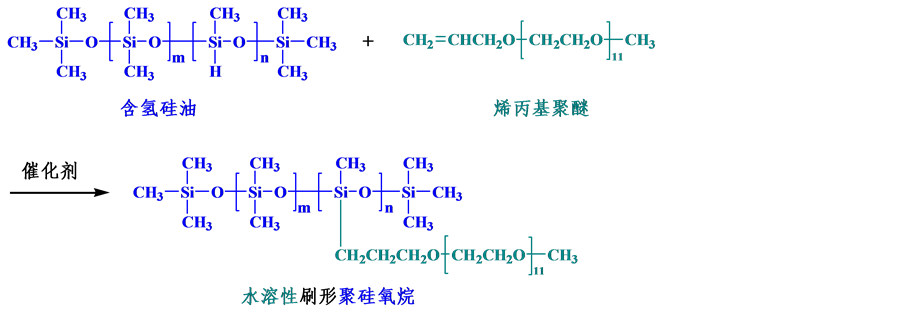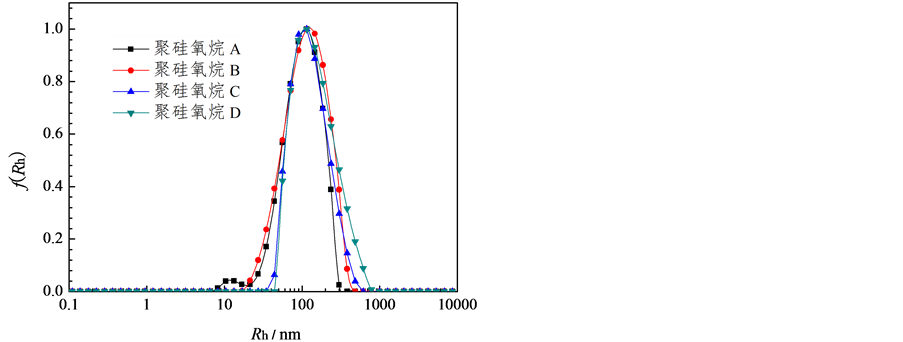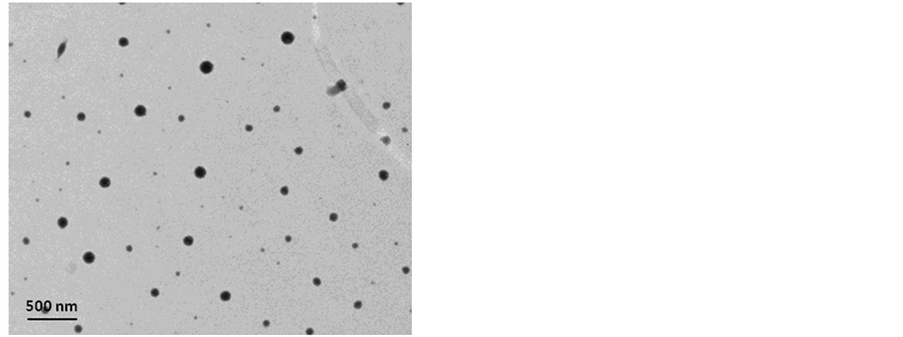1. 引言
研究高分子聚集行为可帮助我们了解高分子体系的作用机制,对相关理论模型的建立及实际应用性能的调控具有重要意义。近年来,国内外学者对各类高分子结构[1] 、溶液浓度 [2] 、混合体系配比 [3] ,环境诱导作用 [4] 等进行了较为深入的研究。水溶性聚硅氧烷是一类新颖的高分子材料,分子结构中包括无机的聚硅氧烷和有机亲水链段,具有优良的耐热性、较低的表面张力、及柔软的手感,已有一些作为高端产品应用在纺织品、造纸、锂电池等领域 [5] 。
目前已有多种树枝状和线型水溶性聚硅氧烷的合成,以及一些功能性的研究工作 [6] 。然而,针对该类高分子形成聚集体微区极性、聚集体尺寸及形貌等分子层面的研究却鲜见报道。本课题组近期研究发现,在水溶性高分子结构中有针对性地引入苯基作为空间位阻基团,可在保证高分子水溶性的前提下,显著提高中疏水侧链的含量(可达90 mol%),形成一类具有密集侧链刷形结构的水溶性高分子 [7] 。水溶性高分子疏水链段显著提升的可行性对两亲高分子的结构设计提供了新的思路,也为我们系统研究结构对该类高分子聚集行为的影响提供了条件。
本工作利用不同含氢量的聚硅氧烷,与聚醚进行硅氢加成反应,合成一系列具有聚硅氧烷疏水主链、不同含量聚醚亲水侧链的刷形结构水溶性聚硅氧烷(图1、表1)。采用表面张力、稳态荧光、动态光散射(DLS)及透射电子显微镜(TEM)研究系列产物的聚集行为。与前期研究工作中刷形高分子相比较 [7] ,本工作主要区别在于高分子结构中同时含有无机和有机链段,以及颠倒的主链和侧链的亲疏水性。本文拟揭示刷形聚硅氧烷在气/液界面的吸附行为,溶液体相中聚集体的微区极性、聚集体的尺寸和形貌,为该类新颖高分子分子层面作用机制的研究提供有效的实验数据。
2. 实验部分
2.1. 实验试剂
氯铂酸购于Aldrich,纯度99%,使用前以1000 ppm浓度溶于异丙醇中低温保存。含氢硅油含氢量

Figure 1. Chemical structure of the water soluble brush-like polysiloxanes. m, n represent the mol% values for each unit, and the values are listed in Table 1
图1. 水溶性聚硅氧烷的分子结构。m、n代表不同链段的含量,数值见表1

Table 1. Compositions of the silicon oil and the water soluble brush-like polysiloxane
表1. 含氢硅油及水溶性聚硅氧烷的结构参数
分别为0.15%、0.35%、0.75%和1.5%,购于江西海多化工有限公司,结构参数的检测结果见表1。含有11个聚醚链段的烯丙基聚醚购于南通市晗泰化工有限公司。芘购于Aldrich,使用前在乙醇中重结晶。甲苯购于北京化学试剂公司,分析纯。
2.2. 水溶性刷形聚硅氧烷的合成
水溶性刷形聚硅氧烷由含氢硅油与烯丙基聚醚之间的硅氢加成反应合成 [8] 。50 g含氢硅油和40 mL甲苯置于250 mL带有氮气入口、滴定漏斗、冷凝管和温度计的四口烧瓶中。室温下通氮气10 min除氧,分20 min滴加烯丙基聚醚(与硅油含活泼氢等摩尔数)和氯铂酸催化剂(总反应物质量万分之一)。反应体系升温至90℃,磁力搅拌下进行反应。体系中两相反应物逐渐变为均一的一相,碘量法跟踪反应转化率,直至反应转化率达97%以上,90℃减压除去体系中的甲苯。红外谱图中2160 cm−1吸收峰以及29Si-NMR谱图中-35 ppm硅氢键特征峰的消失进一步表明反应物的完全转化,产物的结构参数见图1和表1。
2.3. 测试方法
2.3.1
. 溶液的配制
用于表面张力、荧光、DLS和TEM测试的溶液按前期工作中的方法配制。将产物溶解于水中,剧烈搅拌下加热至90℃并继续搅拌15 min。溶液降至室温(降温过程2~2.5 h)后,0.45 μm薄膜滤器过滤并搅拌12小时使溶液体系达到平衡状态。
2.3.2
. 稳态荧光
使用配备温度调节装置的Hitachi F-4500荧光分光光度计(日本)对样品溶液的荧光强度进行测定,测试温度为(25.0 ± 0.5)℃。激发波长设定为335 nm,狭缝宽度为2.5 nm。将1.0 × 10−3 mol∙L−1芘的乙醇溶液注入样品瓶中,自然挥发掉乙醇溶剂。将指定浓度的聚醚硅氧烷溶液注入样品瓶,荧光测试溶液芘的浓度保持在1 × 10−6 mol∙L−1。测试前溶液搅拌过夜,使溶液达到平衡。
2.3.3
. 动态光散射(DLS)
使用配备有ALV-5000数字式时间相关器的ALV/SP-125激光光散射仪(氦-氖光源,波长632.8 nm)对样品溶液进行测试,散射角度为90˚,测试温度为(25.0 ± 0.1)℃。流体力学半径(Rh)由CONTIN软件计算得到。
2.3.4
. 透射电子显微镜(TEM)
透射电镜样品采用负染法制备,使用1%的醋酸酰铀作为染色剂。将一滴待测样品溶液(10~20 μL)滴到干净的石蜡封口膜上,再将覆有碳支持膜的300目铜网小心放在液滴上吸附3~5分钟,多余的液体用滤纸从边缘吸走,形成一层样品膜。将吸附上样品的铜网用同样的方法吸附染液。样品制备好以后,在JEOL-200CX电镜上进行观察,工作电压为100 KV。
3. 结果与讨论
稳态荧光测试结果可提供水溶性分子聚集体微区极性的信息,并可根据疏水微区形成的浓度判断分子的临界聚集浓度(CACs)。图2是荧光发射谱图中第一和第三震动峰比值(I1/I3)对聚硅氧烷浓度的曲线。I1/I3数值随浓度增大而降低表明体系中形成了疏水微区,微区的极性逐渐降低。利用线性外推法,以I1/I3曲线急剧变化的区域确定CAC数值(表2)。线性外推法得到CAC的数值与I1/I3曲线的曲率有关,I1/I3曲线的明显拐点约在0.05 g∙kg−1。有趣的是,随聚硅氧烷结构中亲水侧链含量减少,I1/I3曲线在低于CAC的区域有较明显的平台,该浓度区间聚硅氧烷可能开始聚集并多以分子内的聚集方式形成单分子聚集体。分子结构中亲水侧链数量增大可引起分子间相互作用的增强,限制分子内的聚集方式而促进分子间的聚集方式。
图3是1.0 g∙L−1聚硅氧烷形成聚集体表观流体力学半径(Rh)的分布情况,利用Stokes-Einstein公式计算出Rh的数值列于表2。不同含量疏水侧链聚硅氧烷聚集体的尺寸均分布在几十到上百nm的区间,表明聚硅氧烷以分子间的聚集方式聚集,形成多分子聚集体。Stokes-Einstein公式计算出Rh的数值也只表现出轻微的变化,聚集体尺寸随聚硅氧烷结构中亲水侧链增多而略微增大。图3中可看出聚硅氧烷在1.0 g∙L−1时I1/I3数值随结构中亲水侧链含量增加而增大,表明聚集体的微区极性增大。随亲水侧链含量增加,结合微极性和Rh的同时增大,可判断聚硅氧烷形成较松散的聚集体结构。亲水侧链含量增加可导致更多侧链掺杂在聚集体中,降低聚集体的紧实程度。考虑到图2中I1/I3曲线在低于CAC区域的平缓变化,采用DLS测试了聚硅氧烷浓度为0.01 g∙L−1和0.02 g∙L−1的溶液样品,而浓度降低明显影响了检测信号,微弱的检测信号使测试未得到可靠的Rh结果。
传统有机高分子表面活性剂多有较规律的聚集行为,可形成各类纳米维度的聚集体。本文采用TEM进一步研究了聚硅氧烷聚集体的形貌,图4是聚硅氧烷D 1 g∙L−1浓度溶液中形成聚集体的TEM照片。聚硅氧烷在溶液体相中形成了规整的类似胶束的球形聚集形态,尺寸几十至上百nm。在TEM实验中,不同亲水侧链含量的聚硅氧烷所形成聚集体的形貌没有明显区别,尺寸分布相近,与DLS测试的结果很好吻合。
基于以上聚集体的微极性、聚集体尺寸和形貌等实验结论,关于聚硅氧烷在溶液中聚集行为的示意图见图5。亲水侧链含量对聚集体的尺寸影响很小,可解释为四种聚硅氧烷疏水主链的长度接近,而主

Figure 2. Plots of I1/I3 ratios against the polysiloxane concentrations
图2. I1/I3随聚硅氧烷浓度的变化

Figure 3. Rh distributions for the 1 g∙L−1 polysiloxane solutions
图3. 1 g∙L−1聚硅氧烷溶液中聚集体Rh的分布

Figure 4. TEM image of the assemblies formed by polysiloxane D
图4. 聚硅氧烷D形成的聚集体形貌

Table 2. Critical aggregation concentrations (CACs), and apparent hydrodynamic radius (Rh) of the polysiloxanes
表2. 聚硅氧烷的临界聚集浓度(CACs)、和聚集体的流体力学半径(Rh)

Figure 5. A schematic representation of the aggregation behavior of polysiloxane
图5. 聚硅氧烷聚集行为的示意图
链的疏水性是影响聚硅氧烷在水溶液中聚集体形成的驱动力。此外,大部分的亲水侧链会分布在聚集体的外层伸向水环境中,聚硅氧烷结构中亲水侧链数量的增加会明显增加聚集体表层亲水侧链的密度,而对聚集体尺寸的影响较小。通常情况下,溶液体相中分散的纳米结构尺寸增大会使溶液变浑浊甚至产生体相分离。本工作发现聚集体尺寸不显著增大的前提下,通过提高聚集体表层亲水链段的含量,反而可使溶液体系的状态从浑浊转变为澄清。该分子层面聚集行为与溶液宏观性状的规律性结论可帮助设计具有预期功能的高分子体系。
4. 结语
本文合成了4种不同亲水侧链含量的水溶性刷形聚硅氧烷,采用稳态荧光、DLS和TEM研究了产物的聚集行为。聚硅氧烷亲水侧链数量增多和分子间相互作用的增强会抑制分子在溶液体相中分子内的聚集方式,促进分子间聚集方式和形成多分子的聚集体。聚硅氧烷聚集形成规整的类似胶束的球形聚集体,尺寸几十至上百nm,聚集体尺寸表明分子以分子间的聚集方式形成了多分子聚集体。含有较多亲水侧链的聚硅氧烷形成微极性较大尺寸略大的更松散的聚集体,可能的原因是有更多的亲水侧链掺杂在聚集体中。聚硅氧烷主链的疏水性是溶液体相中聚集体形成的驱动力,侧链数量增多并不明显影响聚集体的尺寸,而是更紧密地分布在聚集体的表层伸向水环境中,增加了聚集体表层亲水侧链的密度。有趣的是,当聚集体表层亲水链段密度增大,溶液从浑浊转变成澄清。该分子层面聚集行为与溶液宏观性状的规律性结论可帮助设计具有预期功能的高分子体系。
致谢
本文工作由国家自然科学基金项目(21406040)和广州市属高校科技计划项目(1201430843)资助。